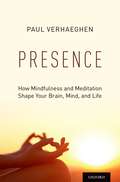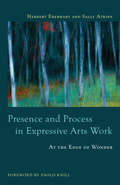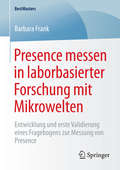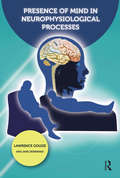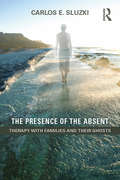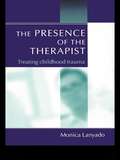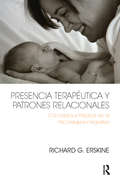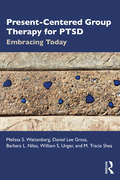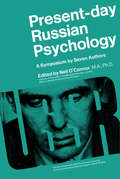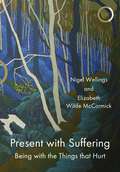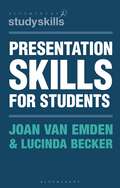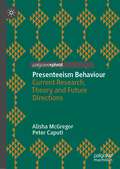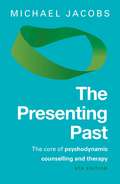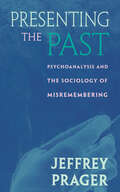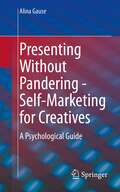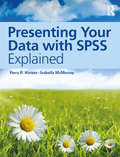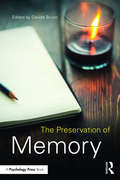- Table View
- List View
Presence: How Mindfulness and Meditation Shape Your Brain, Mind, and Life
by Paul VerhaeghenMindfulness and one of the roads to it, meditation, have become increasingly popular as a way to promote health and well-being. Meditation can create mindfulness in daily life, which becomes an ingrained habit if applied consistently-it can boost immune function; lower levels of stress, anxiety, or depression; lift affect; regulate emotion more easily; and make you happier. Presence reviews how meditation calms the body and what goes on inside the brain during meditation-how it impacts control over attention, awareness of the body, and the experience of self. It examines how meditation leaves telltale lasting traces in brain structure, and how it impacts important areas of life such as well-being, stress, and health. In addition, it examines how mindfulness can be useful as therapy, alleviating depression, anxiety, worry, and pain. A final chapter provides advice on how to meditate and practice mindfulness in a scientifically sound way, based on what we know about how meditation works. Over the last decade, research on these beneficial effects has boomed in the cognitive and behavioral psychology and neuroscience literature, and Presence provides an overview of this research that is thorough and accessible for the curious meditator, seasoned or beginner, as well as for students and practitioners of contemplative science and related fields.
Presence and Process in Expressive Arts Work: At the Edge of Wonder (PDF)
by Herbert Eberhart Paolo J. Knill Sally AtkinsWhat are the basic attitudes, values, and practices that are essential for effective work with the expressive arts? This book explores the answer to that question. The authors examine in depth the concepts of 'presence' - a way of 'being' - and 'process' - an open and trusting way of working - in the professional helping relationship and in the making of art. They introduce readers to the premise of the 'uniqueness of persons' that underpins these ideas, and look at how to realize them in practice. Diverse experiences are also shared of using the arts in group and individual work in a variety of settings, from team building and education to counseling, psychotherapy and supervision. This book is a comprehensive, foundational guide for all practitioners who use the expressive arts as a way of facilitating learning, growth, healing, and change, including expressive arts therapists and students, counsellors, coaches, and other helping professionals. With its clear structure and straight forward style, the book is appropriate also for beginners in these professional fields.
Presence and Process in Expressive Arts Work: At the Edge of Wonder
by Paolo Knill Sally Atkins Herbert EberhartWhat are the basic attitudes, values, and practices that are essential for effective work with the expressive arts? This book explores the answer to that question. The authors examine in depth the concepts of 'presence' - a way of 'being' - and 'process' - an open and trusting way of working - in the professional helping relationship and in the making of art. They introduce readers to the premise of the 'uniqueness of persons' that underpins these ideas, and look at how to realize them in practice. Diverse experiences are also shared of using the arts in group and individual work in a variety of settings, from team building and education to counseling, psychotherapy and supervision. This book is a comprehensive, foundational guide for all practitioners who use the expressive arts as a way of facilitating learning, growth, healing, and change, including expressive arts therapists and students, counsellors, coaches, and other helping professionals. With its clear structure and straight forward style, the book is appropriate also for beginners in these professional fields.
Presence messen in laborbasierter Forschung mit Mikrowelten: Entwicklung und erste Validierung eines Fragebogens zur Messung von Presence (BestMasters)
by Barbara FrankBarbara Frank hat mehr als 24 Presence-Fragebögen verglichen, darauf basierend den Fragebogen „Presence for lab-based micro world research (PLBMR)“ entwickelt und in der Mikrowelt AWAsim analysiert. Der PLBMR kann als Treatment-Check eingesetzt werden, um das Gefühl des „Da Seins“ in einer Simulation zu messen. Er wurde in einer explorativen (N=88) und konfirmatorischen Faktorenanalyse (N=233) untersucht und in einem dritten Schritt validiert. Die Autorin hat einen aufwandsökonomischen sechs-Item Fragebogen mit zwei Faktoren entwickelt, dessen Validität, Reliabilität und Sensitivität gezeigt werden konnte.
Presence of Mind in Neurophysiological Processes
by Jane Desmarais Lawrence GoldieThis book is a study of the simultaneous physiological recordings and psychoanalytic observations when emotional/psychological responses to external stimuli occur pari passu with observed physiological changes. It is the culmination of the author's psychiatric and psychoanalytic work with patients over fifty years, and is based on the simple premise that physiological measurements cannot describe the mind and the mind cannot describe physiological processes. In order for us to have a significant knowledge of the object the author argues that we need both, and that medical specialists and health professionals (doctors, nurses, psychoanalysts, psychotherapists, psychiatrists, etc.) need to be trained to adopt a Complementary approach to patients. The complex relationship between mind and body offers vital clues to the individual's condition, and only by considering patients both physically and mentally can doctors and psychoanalysts make precise and competent judgements.
Presence of Mind in Neurophysiological Processes
by Jane Desmarais Lawrence GoldieThis book is a study of the simultaneous physiological recordings and psychoanalytic observations when emotional/psychological responses to external stimuli occur pari passu with observed physiological changes. It is the culmination of the author's psychiatric and psychoanalytic work with patients over fifty years, and is based on the simple premise that physiological measurements cannot describe the mind and the mind cannot describe physiological processes. In order for us to have a significant knowledge of the object the author argues that we need both, and that medical specialists and health professionals (doctors, nurses, psychoanalysts, psychotherapists, psychiatrists, etc.) need to be trained to adopt a Complementary approach to patients. The complex relationship between mind and body offers vital clues to the individual's condition, and only by considering patients both physically and mentally can doctors and psychoanalysts make precise and competent judgements.
The Presence of the Absent: Therapy with Families and their Ghosts
by Carlos E. SluzkiWhere live our most cherished (or painful) memories? Where do our beloved (or dreaded) exist when departed? In the gray zone between our self and our world, they can exist as internal reminiscences for some and striking images for others; individually or collectively perceived and interacted; vividly or as tenuous presences.This book familiarizes us with six examples of individuals and families in therapy who live and interact with the presence of their absent, pivotal people in their lives who either died or disappeared, but are still there. It familiarizes us with their plight in a tender, compassionate style, describing in detail interviews and therapeutic transformations and, in several cases, follow-ups as well as echoes of those processes. It teaches us to respect those presences as well as how to help families and individuals treasure them…and in many cases to let them go.Written in a vivid, intense language, The Presence of the Absent offers a marvelous insight into these processes that may prove transformative for the therapist (both family and individually-oriented), as well as enlightening to the general public.
The Presence of the Absent: Therapy with Families and their Ghosts
by Carlos E. SluzkiWhere live our most cherished (or painful) memories? Where do our beloved (or dreaded) exist when departed? In the gray zone between our self and our world, they can exist as internal reminiscences for some and striking images for others; individually or collectively perceived and interacted; vividly or as tenuous presences.This book familiarizes us with six examples of individuals and families in therapy who live and interact with the presence of their absent, pivotal people in their lives who either died or disappeared, but are still there. It familiarizes us with their plight in a tender, compassionate style, describing in detail interviews and therapeutic transformations and, in several cases, follow-ups as well as echoes of those processes. It teaches us to respect those presences as well as how to help families and individuals treasure them…and in many cases to let them go.Written in a vivid, intense language, The Presence of the Absent offers a marvelous insight into these processes that may prove transformative for the therapist (both family and individually-oriented), as well as enlightening to the general public.
The Presence of the Therapist: Treating Childhood Trauma
by Monica LanyadoThe Presence of the Therapist uses clinical studies based on the author's publications over the past 18 years to illustrate work with severely distressed children. The reader is encouraged to enter a dialogue with the author to explore the many dilemmas and difficulties of working with a person who has become highly defensive or fearful as a result of what has happened to them. This book is a highly stimulating account of psychotherapeutic practice. It facilitates careful and broad thought about the therapeutic process and relationship that will improve clinical practice. The practical advice on how to survive in this demanding work will be of great benefit to all psychotherapists.
The Presence of the Therapist: Treating Childhood Trauma
by Monica LanyadoThe Presence of the Therapist uses clinical studies based on the author's publications over the past 18 years to illustrate work with severely distressed children. The reader is encouraged to enter a dialogue with the author to explore the many dilemmas and difficulties of working with a person who has become highly defensive or fearful as a result of what has happened to them. This book is a highly stimulating account of psychotherapeutic practice. It facilitates careful and broad thought about the therapeutic process and relationship that will improve clinical practice. The practical advice on how to survive in this demanding work will be of great benefit to all psychotherapists.
Presencia Terapéutica y Patrones Relacionales: Conceptos y Práctica de la Psicoterapia Integrativa
by Richard G. ErskineLa introduccion y los veintiun capitulos de este libro reflejan el continuo desarrollo y perfeccionamiento de Psicoterapia Relacional e Integrativa. Cada capitulo fusiona las ideas de varios marcos teoricos: terapia centrada en cliente, terapia gestalt, analisis transaccional, el psicoanalisis contemporaneo, y psicoterapia auto-psicologia, asi como las perspectivas inter-subjetivas y co-creativo.La teoria de la "Guion de Vida" sirve como un tema unificador para la elaboracion de los conceptos de la experiencia inconsciente, el apego y patrones relacionales, la esencialidad de contacto en la relacion, y la centralidad de las necesidades relacionales en la practica de la psicoterapia. Este libro comienza con ocho supuestos filosoficos, esenciales en la practica de una psicoterapia relacional. Integrado a lo largo de los capitulos es una sensibilidad a los procesos normales del desarrollo y las compensaciones psicologicas que se producen cuando ha habido abandono prolongado y el trauma psicologico. Varias presentaciones de casos ilustran el uso de la investigacion fenomenologica e historica, la sintonia y del desarrollo ritmica, y la importancia de la presencia terapeutica.
Presencia Terapéutica y Patrones Relacionales: Conceptos y Práctica de la Psicoterapia Integrativa
by Richard G. ErskineLa introduccion y los veintiun capitulos de este libro reflejan el continuo desarrollo y perfeccionamiento de Psicoterapia Relacional e Integrativa. Cada capitulo fusiona las ideas de varios marcos teoricos: terapia centrada en cliente, terapia gestalt, analisis transaccional, el psicoanalisis contemporaneo, y psicoterapia auto-psicologia, asi como las perspectivas inter-subjetivas y co-creativo.La teoria de la "Guion de Vida" sirve como un tema unificador para la elaboracion de los conceptos de la experiencia inconsciente, el apego y patrones relacionales, la esencialidad de contacto en la relacion, y la centralidad de las necesidades relacionales en la practica de la psicoterapia. Este libro comienza con ocho supuestos filosoficos, esenciales en la practica de una psicoterapia relacional. Integrado a lo largo de los capitulos es una sensibilidad a los procesos normales del desarrollo y las compensaciones psicologicas que se producen cuando ha habido abandono prolongado y el trauma psicologico. Varias presentaciones de casos ilustran el uso de la investigacion fenomenologica e historica, la sintonia y del desarrollo ritmica, y la importancia de la presencia terapeutica.
Present-Centered Group Therapy for PTSD: Embracing Today
by Melissa S. Wattenberg Daniel Lee Gross Barbara L. Niles William S. Unger M. Tracie SheaPresent-Centered Group Therapy for PTSD integrates theory, research, and practical perspectives on the manifestations of trauma, to provide an accessible, evidence-informed group treatment that validates survivors’ experiences while restoring present-day focus. An alternative to exposure-based therapies, present-centered group therapy provides practitioners with a highly implementable modality through which survivors of trauma can begin to reclaim and invest in their ongoing lives. Chapters describe the treatment’s background, utility, relevant research, implementation, applications, and implications. Special attention is given to the intersection of group treatment and PTSD symptoms, including the advantages and challenges of group treatment for traumatized populations, and the importance of member-driven processes and solutions in trauma recovery. Compatible with a broad range of theoretical orientations, this book offers clinicians, supervisors, mentors, and students a way to expand their clinical repertoire for effectively and flexibly addressing the impact of psychological trauma.
Present-Centered Group Therapy for PTSD: Embracing Today
by Melissa S. Wattenberg Daniel Lee Gross Barbara L. Niles William S. Unger M. Tracie SheaPresent-Centered Group Therapy for PTSD integrates theory, research, and practical perspectives on the manifestations of trauma, to provide an accessible, evidence-informed group treatment that validates survivors’ experiences while restoring present-day focus. An alternative to exposure-based therapies, present-centered group therapy provides practitioners with a highly implementable modality through which survivors of trauma can begin to reclaim and invest in their ongoing lives. Chapters describe the treatment’s background, utility, relevant research, implementation, applications, and implications. Special attention is given to the intersection of group treatment and PTSD symptoms, including the advantages and challenges of group treatment for traumatized populations, and the importance of member-driven processes and solutions in trauma recovery. Compatible with a broad range of theoretical orientations, this book offers clinicians, supervisors, mentors, and students a way to expand their clinical repertoire for effectively and flexibly addressing the impact of psychological trauma.
Present-Day Russian Psychology: A Symposium by Seven Authors
by Neil O'ConnorPresent-Day Russian Psychology is the first comprehensive survey of Russian psychological literature written by bilingual psychologists. This book is composed of seven chapters, and begins with a description of the orienting reflex and the voluntary control of motor behavior. The next chapter discusses the reasons for the disparity between the development of engineering psychology in Russia and in the West and some vigorous attempts by Soviet investigators to close this gap. These topics are followed by discussions on abnormal psychology and psychotherapy, the analysis of psycholinguistic psychology, the studies of child development. The remaining chapters highlight some significant psychological observations to Russian laboratories. This book will be of value to psychologists and historians.
Present with Suffering: Being with the Things that Hurt
by Nigel Wellings Elizabeth Wilde McCormickWhat is the place of discontent and unhappiness in human experience and how best can we be with it? There is something about everything that makes it not quite satisfactory. Even things we really love are spoilt by not being quite enough or by going on too long. People entering psychotherapy want to feel better – more authoritative, less anxious or depressed, more whole – and although it can help, an enormous amount of difficult and painful emotions continue to arise. Even after years and years of therapy many of us feel that there is no ‘happy ever after’. Bearing this reality in mind and drawing upon both psychotherapeutic and Buddhist sources, Present with Suffering, explores bereavement and our pervasive experience of emptiness. It shows how through being mindfully present, kind and accepting, we may enfold what hurts us in a more spacious and meaningful way.
Presentation Skills for Students (Macmillan Study Skills)
by Lucinda Becker Joan van EmdenThis is the essential guide to the most transferable of all student skills: delivering a presentation clearly, coherently and confidently. Written in a friendly and accessible style, it takes the fear out of public speaking and helps students to acquire the skills they need to deliver effective presentations at university and in their future careers. Revised and updated throughout, it provides readers with practical guidance on controlling their nerves, creating visual aids and structuring presentations. This is an invaluable resource for students of all disciplines in further or higher education who have to give presentations as part of their course. It is also ideal for recent graduates looking to hone their presentation skills as they enter the job market.
Presenteeism Behaviour: Current Research, Theory and Future Directions
by Alisha McGregor Peter CaputiThis book presents a concise and contemporary account of theory and research on presenteeism. It thoroughly discusses the definition and measurement of presenteeism, followed by an overview of the presenteeism literature focusing on key areas such as the prevalence, causes, consequences, costs and benefits of presenteeism. It reviews the models of presenteeism, and how they have been used to explain presenteeism behavior in the workplace. The authors offer an overview of presenteeism interventions and suggestions for future interventions, as well as recommendations for future research studies on presenteeism.
The Presenting Past: The Core Of Psychodynamic Counselling And Therapy (UK Higher Education OUP Humanities & Social Sciences Counselling and Psychotherapy)
by Michael Jacobs"This text is characterised by the insight and authority of practice based evidence rather than being primarily theory applied to practice ... It is also written accessibly, with sometimes difficult psychodynamic concepts rendered into plain but elegant prose ... Convincing case studies are used throughout and summaries helpfully link practice issues with theory."Therapy Today, May 2013"This new edition of The Presenting Past is a wonderfully readable overview of the developmental principles underlying psychodynamic counselling. Theories of Freud, Klein, Bowlby, Winnicott, Kohut and others are organized into three broad developmental themes: trust and attachment; authority and autonomy; and cooperation and competition. It is illuminated with rich clinical examples which bring alive how theory is helpful to understanding clients. Jacobs' lucid, lively style makes the connection between theory and practice clear and accessible. This outstanding book will appeal to established clinicians as well as students training in counselling and psychotherapy." Jan Grant, Associate Professor, Counselling Psychology, Curtin University, Western Australia"Michael Jacobs is a free spirit who roams purposefully in the often contentious world of the rival psychoanalytic traditions."Professor Brian Thorne, Centre for Counselling Studies, University of East Anglia, UK"An original and reliable approach to the development of personality that every therapist and student therapist should possess. Jacobs, one of the founders of psychodynamic therapy and counselling, avoids the twin perils of unimaginative, meaningless causality on the one hand and indifferent, irresponsible reference to fate on the other."Andrew Samuels, Professor of Analytical Psychology, University of Essex, UK"In this fourth edition of what is a seminal text on psychodynamic ways of working, Michael Jacobs has managed to take the reader through the complex and intricate ways of thinking about what it is to be human from a psychodynamic view of the world. This text has been recommended reading for undergraduates that I teach who are studying the world of counselling and helping and it continues to be a text that they draw on when faced with a difficulty in understanding the ideas and concepts of the psychodynamic approach. Michael Jacobs has that rare ability to make complicated ideas and concepts seem understandable and yet leave the reader in no doubt that they are complicated. The use of case material brings the theory to live and mirrors Michael's commitment to practice that is informed by theory. This is a vade mecum and Michael has 'done the job'."Sue Sully, Senior Lecturer in Counselling and Psychotherapy, University of Brighton, UKA person's past is ever present, from infancy to old age, and it affects the dynamics of therapy and the therapist-patient relationship. Written by a key founding figure of psychodynamic counselling and one of most-cited counselling authors in Europe, the bestselling The Presenting Past gives practicing therapists and students keen insight into the subject. The theories of Freud, Winnicott, Klein and attachment theorists are organized into three main categories: trust and attachment; authority and autonomy; and cooperation and competitiveness. In this new edition, Michael Jacobs gives psychodynamic counselling and therapy a truly human face. He brings practice to the forefront in a new three-part structure. This is realized through the swift introduction of the themes in the therapeutic relationship throughout the book, making integration of theory and practice clearer than ever. Looking at what the client presents as troubling them, what the therapist experiences about the client and their relationship in therapy and exploring theories to throw light on these themes now lies firmly at the core of the book. Fully updated with new references, The Presenting Past stays wonderfully readable. The book shows Jacobs at his best and is a testimony to his lifetime of experience.
Presenting the Past: Psychoanalysis and the Sociology of Misremembering
by Jeffrey PragerPsychology is the dogma of our age; psychotherapy is our means of self-understanding; and "repressed memory" is now a universally familiar form of trauma. Jeffrey Prager, who is both a sociologist and a psychoanalyst, explores the degree to which we manifest the clichés of our culture in our most private recollections. At the core of Presenting the Past is the dramatic and troubling case of a woman who during the course of her analysis began to recall scenes of her own childhood sexual abuse. Later the patient came to believe that the trauma she remembered as a physical violation might have been an emotional violation and that she had composed a memory out of present and past relationships. But what was accurate and true? And what evidence could be persuasive and valuable? Could the analyst trust either her convictions or his own? Using this case and others, Prager explores the nature of memory and its relation to the interpersonal, therapeutic, and cultural worlds in which remembering occurs. Synthesizing research from social science, psychoanalysis, neuroscience, and cognitive psychology, Prager uses clinical examples to argue more generally that our memories are never simple records of events, but constantly evolving constructions, affected by contemporary culture as well as by our own private lives. He demonstrates the need that sociology has for the insights of psychoanalysis, and the need that psychoanalysis has for the insights of sociology.
Presenting Without Pandering - Self-Marketing for Creatives: A Psychological Guide
by Alina GauseThis guidebook helps people in creative professions or with creative career goals to "sell themselves better." It promises to build a sustainable strategy by considering personal and artistic as well as marketing aspects. The foundation is a review of the particular psychological hurdles creative personalities face in self-promotion. Based on this, practical, individual exercises lead to a personal guideline. Numerous case studies also provide insight into their experiences. Singers, actors, scenographers, directors, authors, musicians and visual artists may feel equally addressed by this as cooks, designers or other creative souls. Self-marketing can be fun. And fun is the only fuel that convinces creatives. Not in the sense of a short thrill or light entertainment, but of fulfillment, visionary meaningfulness and flow experience. Readers of this book can expect nothing less than that.This book is a translation of the original German 1st edition Anbieten ohne Anbiedern - Selbstmarketing für Kreative by Alina Gause, published by Springer-Verlag GmbH Germany, part of Springer Nature in 2021. The translation was done with the help of artificial intelligence (machine translation by the service DeepL.com). A subsequent human revision was done primarily in terms of content, so that the book will read stylistically differently from a conventional translation. Springer Nature works continuously to further the development of tools for the production of books and on the related technologies to support the authors.
Presenting Your Data with SPSS Explained
by Perry R. Hinton Isabella McMurrayData Presentation with SPSS Explained provides students with all the information they need to conduct small scale analysis of research projects using SPSS and present their results appropriately in their reports. Quantitative data can be collected in the form of a questionnaire, survey or experimental study. This book focuses on presenting this data clearly, in the form of tables and graphs, along with creating basic summary statistics. Data Presentation with SPSS Explained uses an example survey that is clearly explained step-by-step throughout the book. This allows readers to follow the procedures, and easily apply each step in the process to their own research and findings. No prior knowledge of statistics or SPSS is assumed, and everything in the book is carefully explained in a helpful and user-friendly way using worked examples. This book is the perfect companion for students from a range of disciplines including psychology, business, communication, education, health, humanities, marketing and nursing – many of whom are unaware that this extremely helpful program is available at their institution for their use.
Presenting Your Data with SPSS Explained
by Perry R. Hinton Isabella McMurrayData Presentation with SPSS Explained provides students with all the information they need to conduct small scale analysis of research projects using SPSS and present their results appropriately in their reports. Quantitative data can be collected in the form of a questionnaire, survey or experimental study. This book focuses on presenting this data clearly, in the form of tables and graphs, along with creating basic summary statistics. Data Presentation with SPSS Explained uses an example survey that is clearly explained step-by-step throughout the book. This allows readers to follow the procedures, and easily apply each step in the process to their own research and findings. No prior knowledge of statistics or SPSS is assumed, and everything in the book is carefully explained in a helpful and user-friendly way using worked examples. This book is the perfect companion for students from a range of disciplines including psychology, business, communication, education, health, humanities, marketing and nursing – many of whom are unaware that this extremely helpful program is available at their institution for their use.
The Preservation of Memory
by Davide BrunoAn increase in average life expectancy has given rise to a number of pressing health challenges for the 21st century. Age-related memory loss, whether due to a neurodegenerative condition such as Alzheimer’s disease, or as a product of the normal process of aging, is perhaps the most significant of the health problems of old age presently confronting our society. The Preservation of Memory explores non-invasive, empirically sound strategies that can be implemented to ensure long-lasting and effective retention of information. The chapters in this volume describe and evaluate both well-established and novel methods for improving and strengthening memory, for people with and without dementia. They also look at ways in which effective detection and care can be implemented, and describe empirical findings that can be translated into everyday practice. The contributors take a multidisciplinary approach, motivated by the desire to look beyond and across boundaries to find new areas of knowledge and new opportunities. The Preservation of Memory will be useful reading for students and researchers focusing upon memory, aging and dementia, and also for mental health practitioners, social workers, and carers of persons living with dementia or other memory impairments.
The Preservation of Memory
by Davide BrunoAn increase in average life expectancy has given rise to a number of pressing health challenges for the 21st century. Age-related memory loss, whether due to a neurodegenerative condition such as Alzheimer’s disease, or as a product of the normal process of aging, is perhaps the most significant of the health problems of old age presently confronting our society. The Preservation of Memory explores non-invasive, empirically sound strategies that can be implemented to ensure long-lasting and effective retention of information. The chapters in this volume describe and evaluate both well-established and novel methods for improving and strengthening memory, for people with and without dementia. They also look at ways in which effective detection and care can be implemented, and describe empirical findings that can be translated into everyday practice. The contributors take a multidisciplinary approach, motivated by the desire to look beyond and across boundaries to find new areas of knowledge and new opportunities. The Preservation of Memory will be useful reading for students and researchers focusing upon memory, aging and dementia, and also for mental health practitioners, social workers, and carers of persons living with dementia or other memory impairments.
